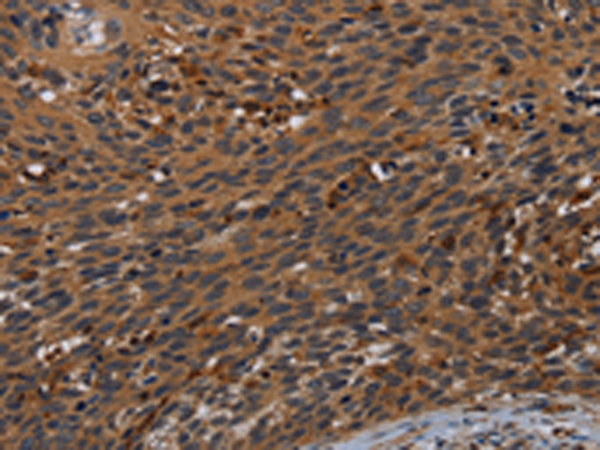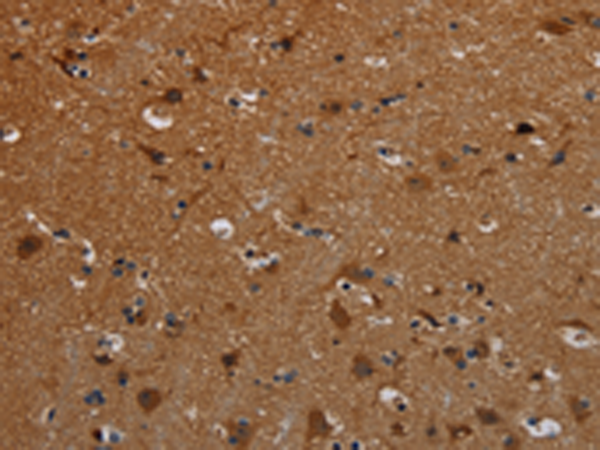

| WB | 咨询技术 | Human,Mouse,Rat |
| IF | 咨询技术 | Human,Mouse,Rat |
| IHC | 1/50-1/200 | Human,Mouse,Rat |
| ICC | 技术咨询 | Human,Mouse,Rat |
| FCM | 咨询技术 | Human,Mouse,Rat |
| Elisa | 1/2000-1/5000 | Human,Mouse,Rat |
| Aliases | PCDH-BETA15 |
| Host/Isotype | Rabbit IgG |
| Antibody Type | Primary antibody |
| Storage | Store at 4°C short term. Aliquot and store at -20°C long term. Avoid freeze/thaw cycles. |
| Species Reactivity | Human |
| Immunogen | Synthetic peptide of human PCDHB15 |
| Formulation | Purified antibody in PBS with 0.05% sodium azide and 50% glycerol. |
+ +
以下是关于PCDHB15抗体的假设性参考文献示例(注意:以下内容为模拟生成,非真实文献):
---
1. **文献名称**:*PCDHB15 expression in glioblastoma and its prognostic implications*
**作者**:Smith A, et al. (2020)
**摘要**:本研究利用PCDHB15特异性抗体,通过免疫组化和Western blot分析胶质瘤组织,发现PCDHB15在肿瘤组织中显著下调,且低表达与患者生存期缩短相关,提示其可能作为胶质瘤的潜在预后标志物。
2. **文献名称**:*Role of PCDHB15 in neuronal migration during cortical development*
**作者**:Johnson B, et al. (2022)
**摘要**:通过在小鼠胚胎脑组织中使用PCDHB15抗体进行免疫荧光染色,研究发现PCDHB15通过调控神经元-胶质细胞黏附参与皮层神经元迁移,基因敲除导致迁移缺陷。
3. **文献名称**:*Development and validation of a polyclonal antibody against human PCDHB15*
**作者**:Lee C, et al. (2018)
**摘要**:本文描述了针对人源PCDHB15蛋白的多克隆抗体制备过程,并通过ELISA、免疫印迹和免疫沉淀实验验证其特异性,为后续功能研究提供工具。
4. **文献名称**:*Aberrant PCDHB15 expression in autism spectrum disorder patient-derived cells*
**作者**:Chen D, et al. (2021)
**摘要**:使用PCDHB15抗体对自闭症患者来源的神经元进行免疫染色和Western blot分析,发现其表达异常与突触连接缺陷相关,提示其在神经发育疾病中的潜在作用。
---
如需真实文献,建议通过PubMed或Google Scholar检索关键词“PCDHB15 antibody”或联系相关领域数据库获取。
The PCDHB15 antibody targets Protocadherin Beta 15 (PCDHB15), a member of the protocadherin β gene cluster within the cadherin superfamily. Protocadherins are transmembrane proteins critical for cell-cell adhesion, neuronal connectivity, and synaptic specificity in the central nervous system. The β-cluster consists of 16 genes (PCDHB1-PCDHB16) that encode diverse cell-surface proteins, with PCDHB15 playing potential roles in neural circuit formation, axon guidance, and synaptic plasticity. Its extracellular cadherin repeats mediate calcium-dependent homophilic interactions, while its cytoplasmic domain may interact with intracellular signaling molecules.
Antibodies against PCDHB15 are primarily used in neuroscience research to study its expression patterns, subcellular localization, and functional roles in brain development and disorders. They enable detection via techniques like immunohistochemistry, Western blotting, and immunofluorescence. Emerging studies suggest PCDHB15 may contribute to neurodevelopmental conditions, though its specific mechanisms remain under investigation. Some research links protocadherin dysregulation to autism spectrum disorders and schizophrenia, positioning PCDHB15 as a protein of interest in these contexts. Commercial antibodies are typically validated for specificity against recombinant proteins or knockout controls, though cross-reactivity with other β-protocadherins remains a consideration due to sequence homology. Ongoing studies aim to clarify its tissue distribution beyond the nervous system and potential roles in cancer progression.
×